Who Controls the User Experience? AMD’s Carrizo Thoroughly Tested
by Ian Cutress on February 4, 2016 8:00 AM ESTBenchmark Results: Professional and OpenCL
Here are our results from our Professional and OpenCL tests. A reminder of our systems, including their graphics:
| System Overview | ||||
| µArch | APU + GPU | Memory | Channel | |
| HP Elitebook 745 G2 | Kaveri | A10 PRO-7350B (19W) R6, 384 SPs, 533 MHz |
8 GB | Dual |
| HP Elitebook 745 G3 | Carrizo | PRO A12-8800B (15W) R7, 512 SPs, 800 MHz |
4 GB | Single |
| Toshiba Satellite E45DW-C4210 |
Carrizo | FX-8800P (15W) R7, 512 SPs, 800 MHz |
8 GB | Single |
| HP Pavilion 17z-g100 |
Carrizo | A10-8700P (15W) R6, 384 SPs, 800 MHz |
8 GB | Single |
| Lenovo Y700 | Carrizo | FX-8800P (15W) R7, 512 SPs, 800 MHz R9 385MX, 512 SPs, 900-100 MHz |
16 GB | Single |
PCMark 08
PCMark08, developed by Futuremark, is a simple press play and run benchmarking tool designed to probe how well systems cope with a variety of standard tasks that a professional user might encounter. This includes video conferencing with multiple streams, image/file manipulation, video processing, 3D modelling and other tools. In this case we take the three main benchmark sets, Creative, Home and Work, and run them in OpenCL mode which aims to take advantage of OpenCL accelerated hardware. For fun we also put in the PCMark08 Storage workset.
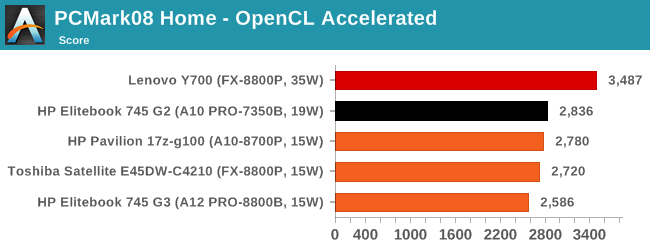
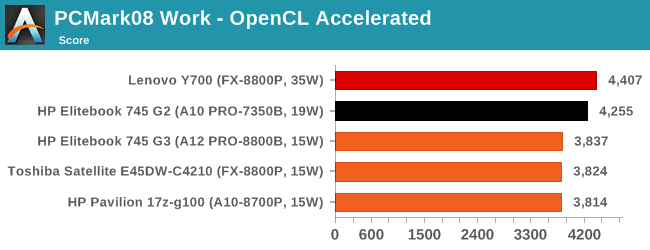
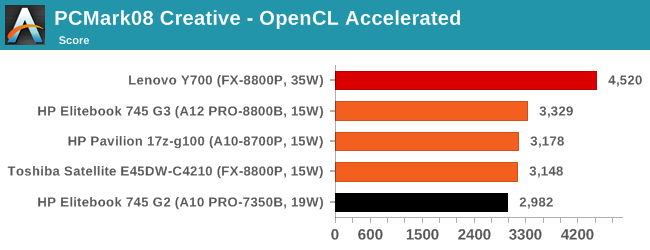
Both of the Home and Work tests show something starteling in the Kaveri system beating all the 15W Carrizo parts. This comes back to what we saw on WebXPRT on the last page – these workloads are very bursty in nature, requiring the system to wake up, run a small amount of work, and go back to sleep. It would seem that this requires a lot more effort from the Carrizo platforms than the Kaveri ones (perhaps by nature of the lower idle power draw starting point on Carrizo) which impacts time critical performance metrics.
If we take the CPU frequencies of the two Elitebook systems, starting with the 745 G2 (Kaveri)
Here the standard frequency tends to be in the 3300 MHz region, moving down to lower frequencies when more threads are needed. But for the 745 G3 (Carrizo):
Here the CPU frequency is obviously mostly at the 2500 MHz mark, sometimes bursting up to 3400 MHz (It’s actually more of a 2:1 split in favor of 2500 MHz).
You might argue that the temperature of the design might be to blame. Both Elitebooks are in the same chassis, so let us see:
(take note of the scales)
Here it shows the G2 wanting to stay below 60C, whereas the G3 is happy to go almost to 80C, albeit with an average temperature which is nearer 50C. This means that the G2 can arguably keep the higher frequencies for longer.
Just to weigh in on the other 15W Carrizo designs in the Toshiba Satellite and HP Pavilion:
In both cases, similar to the G3, the main frequency for the test is actually the lower 2500/2300 frequency, with the system moving up to the higher frequency state around a third of the time, rather than staying at the higher state and moving back down. This is what is causing the Kaveri system to win out in these sorts of workloads (though likely at a power penalty).
On the storage front, having a mechanical drive is a killer here.

Agisoft Photoscan
Photoscan is professional software that takes a series of 2D images (as little as 50, usually 250+) and 'performs calculations' to determine where the pictures were taken and if it can create a 3D model and textures of what the images are of. This model can then be exported to other software for touch-ups or implementation in physics engines/games or, as the reader that directed me to it, national archiving. The tool has four phases, one of which can be OpenCL accelerated, while the other three are a mix of single thread and variable thread workloads. We ran the tool in CPU only and OpenCL modes.
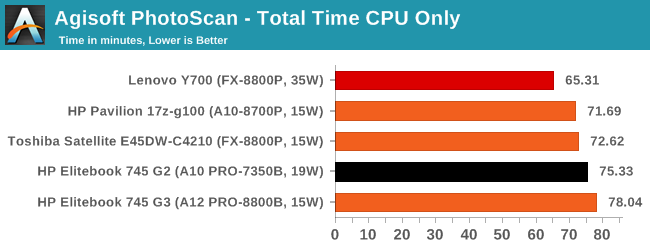
When pure CPU performance matters, having the higher thermal headroom matters most. But moving it to the OpenCL mode shows that those extra TDP points can matter a lot on load balancing:
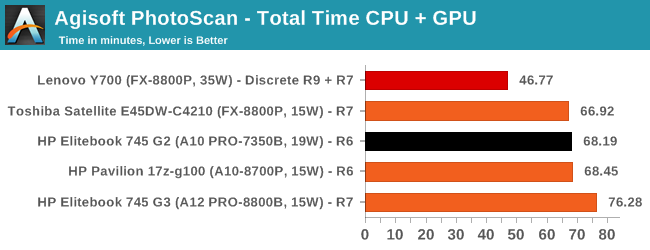
There are two things to note here. One, something seems to have gone very wrong with the G3, and I’m sure those numbers are erroneous and need to be re-run or the 4GB of memory is actually a hindrance here. The second is that the combination R7/R9 graphics in the Lenovo, despite not being in Crossfire, can both be used in OpenCL mode. This pushes a speed up of almost 30%.
Linux Bench
Linux Bench is a collection of Linux based benchmarks compiled together by ServeTheHome. The idea for this is to have some non-windows based tools that are easy enough to run with a USB key, an internet connection and three lines of code in a terminal. The tests in Linux Bench include standard synthetic compute, compression, matrix manipulation, database tools and key-value storage.
Unfortunately Linux Bench refused to run on any of the HP systems for relatively unknown reasons – the fact that it was all the HP models perhaps means that there is something firmware related which is causing the LiveCD to not boot properly. Nonetheless, the results are here for completeness.
| Linux Bench | ||
| Toshiba Satellite E45DW-C4210 (15W) |
Lenovo Y700 (35W) |
|
| C-Ray Hard Test / seconds | 365 | 267 |
| 7-Zip Compression MIPS | 5718 | 6110 |
| 7-Zip Decompression MIPS | 7320 | 9733 |
| NAMD (steps per time) | 1.72 | 2.46 |
| NPB MOPS (per sec per thread) | 365 | 321 |
| OpenSSL Sign | 220 | 296 |
| OpenSSL Verify | 13518 | 19465 |
| Redis 1 | 13210 | 12034 |
| Redis 10 | 41494 | 38760 |
| Redis 100 | 33445 | 31949 |






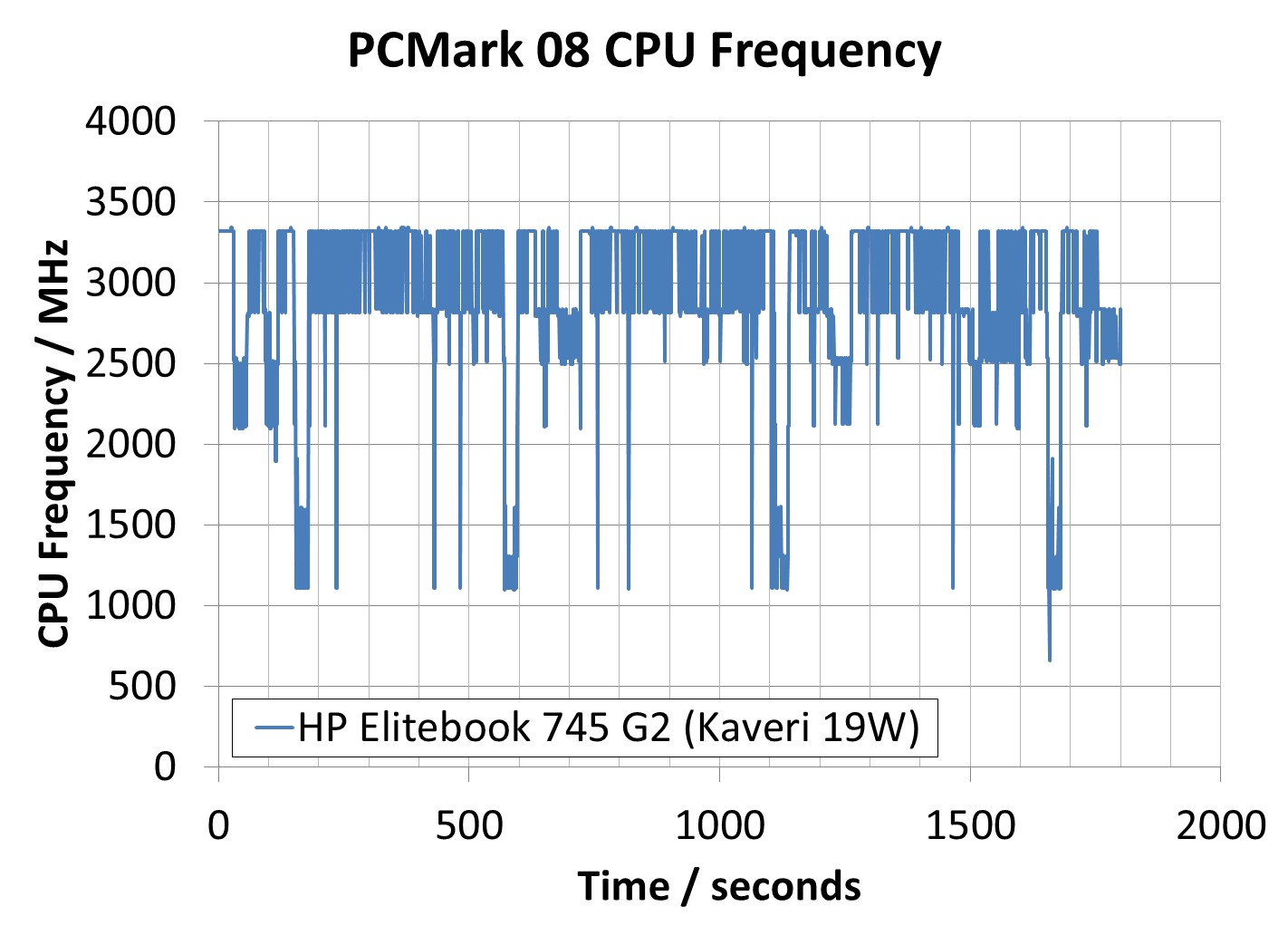

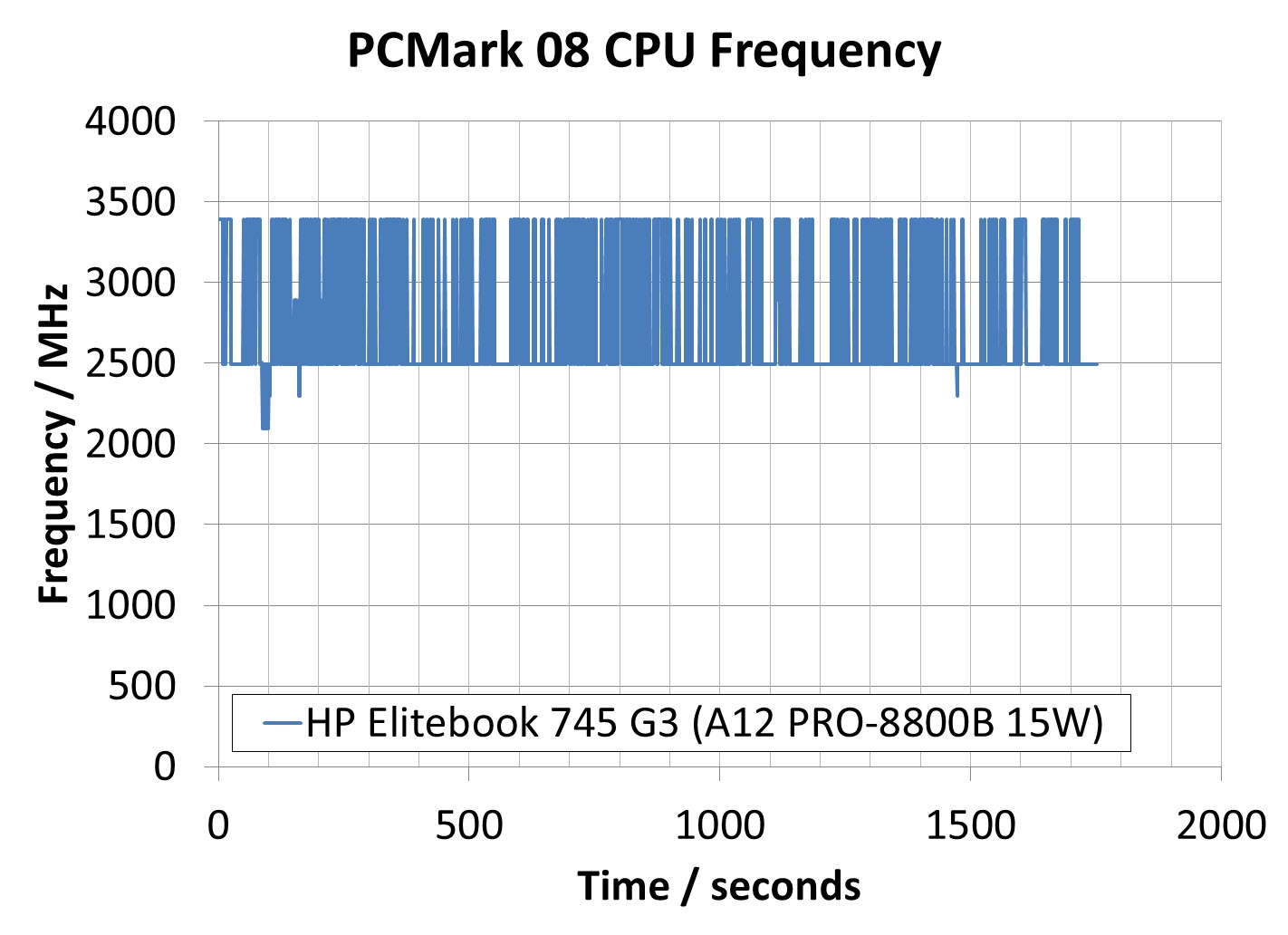
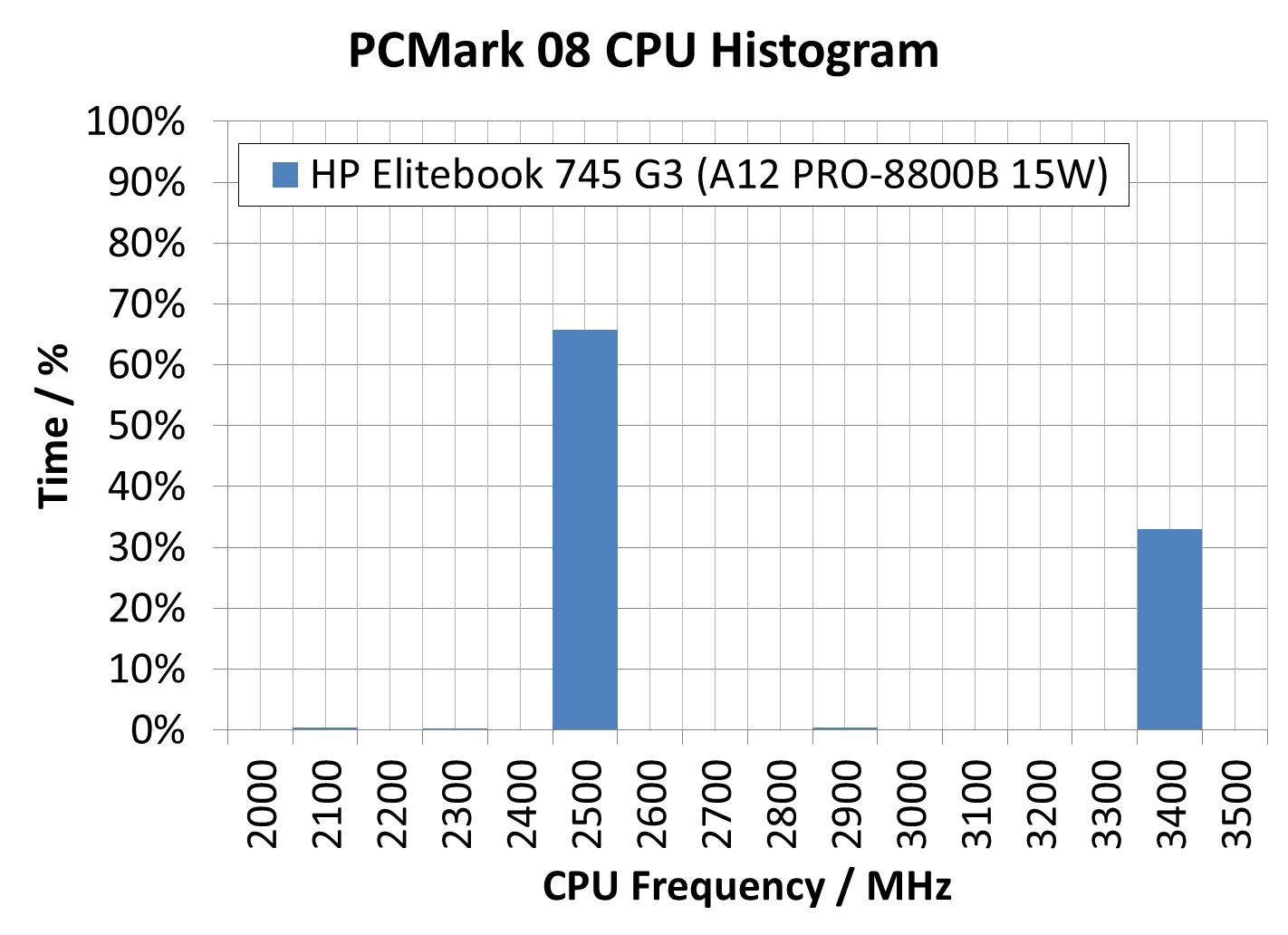

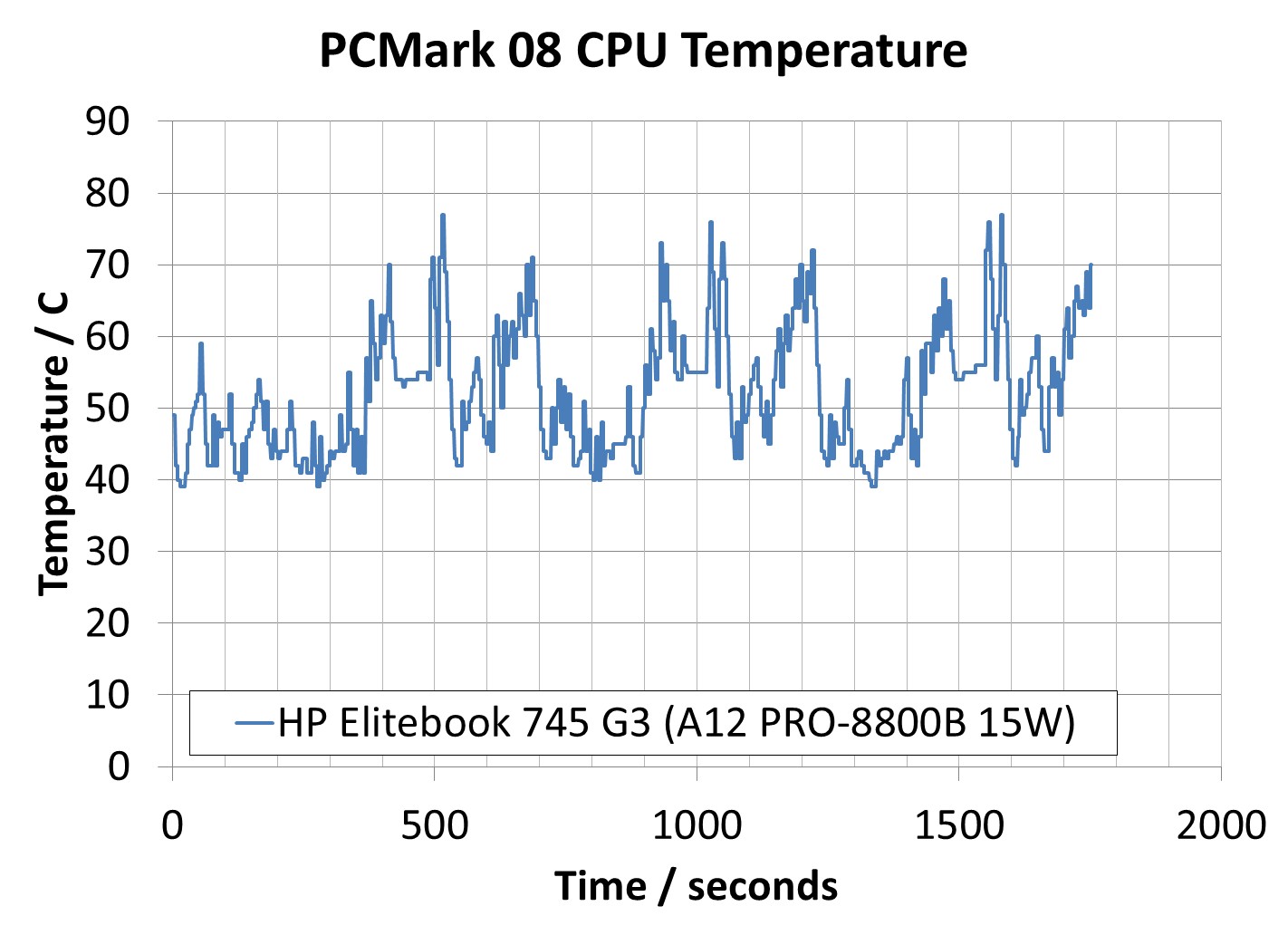










175 Comments
View All Comments
Squinoogle - Saturday, February 27, 2016 - link
An interesting read. I'll say I'm glad you went to the bother even if the ends weren't quite what you were expecting from the outset.I agree that it would be quite interesting to see someone make a proper halo device to showcase Carrizo at its best, rather than the trend of taking an established Intel chassis and then stuffing a hobbled AMD configuration inside it.
Speaking of which, I had a look at the HP UK website since I remembered seeing exactly that situation in the past (was an Envy 15 model that time) and came across an interesting trio of devices:
Three models from the Pavilion Black Edition range, all three using the same chassis and internal components, the only difference being the wifi card on the A10 model is upgraded.
http://store.hp.com/UKStore/Merch/Product.aspx?id=... - Core i3-6100U £459
http://store.hp.com/UKStore/Merch/Product.aspx?id=... - A10-8780P + R7 M360 £529
http://store.hp.com/UKStore/Merch/Product.aspx?id=... - Core i5-6200U £549
I'd be interested in seeing a true apples-to-apples comparison between devices like these, where the Intel and AMD models are priced and specified so closely together.
Gc - Sunday, February 28, 2016 - link
Another Carrizo 'capability' not implemented:Carrizo was advertised as the first architecture to support full HSA 1.0, but ...
Can any retail Carrizo systems run HSA?
As I understand, to run HSA currently requires installing Linux and the HSA driver.
(Possible running the HSA Docker container on this host, but the host must have the HSA driver.)
https://github.com/HSAFoundation/HSA-Docs-AMD/wiki...
https://github.com/HSAFoundation/HSA-Drivers-Linux...
The only test system listed is a "A88X-PRO" desktop motherboard and Kaveri "A10-7850K" APU.
(No Carrizo chips are available for that socket.)
The host must have "the IOMMU enabled in the BIOS".
This is the IOMMU of the GPU, typically under Graphics Configuration in the BIOS.
https://community.amd.com/thread/169962
However, I have not seen any retail Carrizo systems that implement that BIOS option. Do they exist? (The closest thing is the option to enable AMD-V as required for Docker, but that is not the same thing, as the above link indicates.)
If not, why not? (Is an effort/investment needed to get the support into common AMD chip BIOS/UEFIs used by ODMs, similar like it was needed to get support into the Linux kernel?)
albert89 - Wednesday, March 23, 2016 - link
Although I congratulate Anandtech after repeated demands from consumers like myself as to why a review of Carrizo wasn't done sooner the result is a review that leaves one ask many questions and a demand for another review since new info has come to light.So redo the whole review under dual channel conditions for AMD's Carrizo. Otherwise you'll be leaving this review incomplete and short changing a competitor of Intel leaving us to wonder how bias Anandtech is towards AMD !
DJ Dave - Saturday, March 25, 2017 - link
hey.i just bought this as a refurb. it seems to lag/stutter with certain programs. Mine has 2 ram slots with 4gb in each..does anyone know if that can be upgraded?krissh6563 - Sunday, August 9, 2020 - link
Sir I have Hp Elite-book 745 G2 laptop. Now I am facing overheating problem in my laptop. So what should I do.